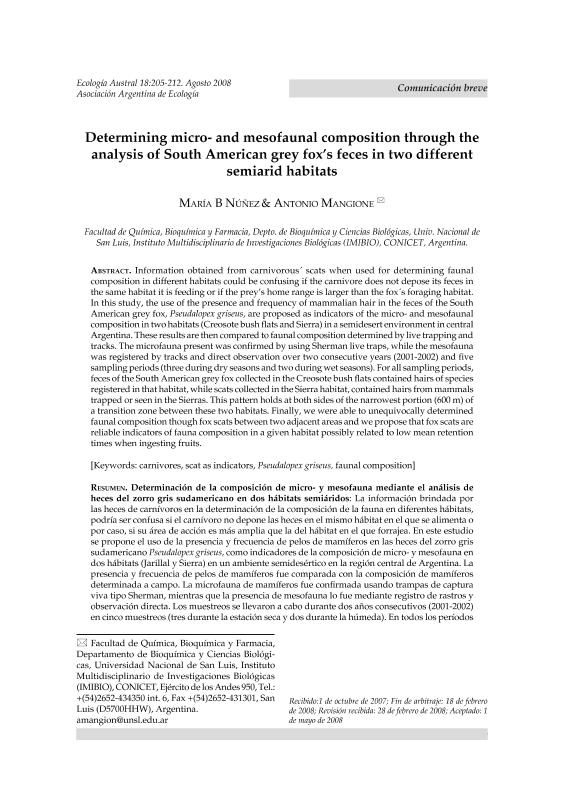Mostrar el registro sencillo del ítem
dc.contributor.author
Nuñez, Maria Beatriz

dc.contributor.author
Mangione, Antonio Marcelo

dc.date.available
2020-09-09T13:47:01Z
dc.date.issued
2008-08
dc.identifier.citation
Nuñez, Maria Beatriz; Mangione, Antonio Marcelo; Determining micro- and mesofaunal composition through the analysis of South American grey fox’s feces in two different semiarid habitats; Asociación Argentina de Ecología; Ecología Austral; 18; 2; 8-2008; 205-212
dc.identifier.issn
1667-782X
dc.identifier.uri
http://hdl.handle.net/11336/113622
dc.description.abstract
Information obtained from carnivorous´ scats when used for determining faunal composition in different habitats could be confusing if the carnivore does not depose its feces in the same habitat it is feeding or if the prey’s home range is larger than the fox´s foraging habitat. In this study, the use of the presence and frequency of mammalian hair in the feces of the South American grey fox, Pseudalopex griseus, are proposed as indicators of the micro- and mesofaunal composition in two habitats (Creosote bush flats and Sierra) in a semidesert environment in central Argentina. These results are then compared to faunal composition determined by live trapping and tracks. The microfauna present was confirmed by using Sherman live traps, while the mesofauna was registered by tracks and direct observation over two consecutive years (2001-2002) and five sampling periods (three during dry seasons and two during wet seasons). For all sampling periods, feces of the South American grey fox collected in the Creosote bush flats contained hairs of species registered in that habitat, while scats collected in the Sierra habitat, contained hairs from mammals trapped or seen in the Sierras. This pattern holds at both sides of the narrowest portion (600 m) of a transition zone between these two habitats. Finally, we were able to unequivocally determined faunal composition though fox scats between two adjacent areas and we propose that fox scats are reliable indicators of fauna composition in a given habitat possibly related to low mean retention times when ingesting fruits.
dc.format
application/pdf
dc.language.iso
eng
dc.publisher
Asociación Argentina de Ecología

dc.rights
info:eu-repo/semantics/openAccess
dc.rights.uri
https://creativecommons.org/licenses/by-nc-sa/2.5/ar/
dc.subject
CARNIVORES
dc.subject
SCAT AS INDICATORS
dc.subject
PSEUDOLAPEX GRISEUS
dc.subject
FAUNAL COMPOSITION
dc.subject.classification
Ecología

dc.subject.classification
Ciencias Biológicas

dc.subject.classification
CIENCIAS NATURALES Y EXACTAS

dc.title
Determining micro- and mesofaunal composition through the analysis of South American grey fox’s feces in two different semiarid habitats
dc.type
info:eu-repo/semantics/article
dc.type
info:ar-repo/semantics/artículo
dc.type
info:eu-repo/semantics/publishedVersion
dc.date.updated
2020-07-22T15:43:25Z
dc.identifier.eissn
0327-5477
dc.journal.volume
18
dc.journal.number
2
dc.journal.pagination
205-212
dc.journal.pais
Argentina

dc.journal.ciudad
Buenos Aires
dc.description.fil
Fil: Nuñez, Maria Beatriz. Consejo Nacional de Investigaciones Científicas y Técnicas. Centro Científico Tecnológico Conicet - San Luis. Instituto Multidisciplinario de Investigaciones Biológicas de San Luis. Universidad Nacional de San Luis. Facultad de Ciencias Físico Matemáticas y Naturales. Instituto Multidisciplinario de Investigaciones Biológicas de San Luis; Argentina
dc.description.fil
Fil: Mangione, Antonio Marcelo. Consejo Nacional de Investigaciones Científicas y Técnicas. Centro Científico Tecnológico Conicet - San Luis. Instituto Multidisciplinario de Investigaciones Biológicas de San Luis. Universidad Nacional de San Luis. Facultad de Ciencias Físico Matemáticas y Naturales. Instituto Multidisciplinario de Investigaciones Biológicas de San Luis; Argentina
dc.journal.title
Ecología Austral

dc.relation.alternativeid
info:eu-repo/semantics/altIdentifier/url/http://ojs.ecologiaaustral.com.ar/index.php/Ecologia_Austral/issue/view/28
Archivos asociados
